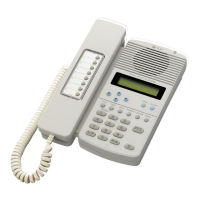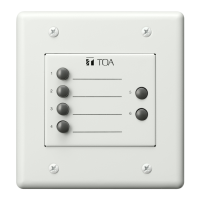Chapter 1 GENERAL DESCRIPTION Page: 18 1. General Description Overview of the N-8000 Series packet intercom system, its IP network compatibility, and conversation methods.
2. Features Key features of the system, including exchange types, station types, and interface units.
4. Specifications Technical specifications of the system, including connectable units, line capacity, and paging capabilities.
7. System Function Table Table outlining basic functions of master stations, including conversation, speed dialing, and incoming call selection.
9. Paging Function Outlines Overview of paging types (PA paging, Station paging) and functions like zone, selectable, and all-call paging.
Chapter 3 INSTALLATION & WIRING Page: 305 10. Installation of Substations Instructions for flush mounting and wall surface mounting of substations like RS-150, RS-160, RS-170, RS-450, RS-460, RS-470, RS-480.
13. Wiring Detailed wiring instructions for various connections, including exchange, stations, interface units, and external devices.
Chapter 4 SYSTEM DESIGN FLOW Page: 389 3. Setting Procedures Steps for setting up the network, performing system settings, and saving/uploading configurations.
5.4. Sub Stations Network and function settings for Sub Stations, including IP address, call forwarding, and priority levels.
5.5. IP Stations Network and function settings for IP Stations, covering call forwarding, paging, and access control.
5.6. Stations Settings for stations connected to exchanges or substation interface units, including incoming call mode and group call.
5.7. C;O Interface Network and function settings for C/O Interface units, including timeouts and calling station indication.
5.8. Telephone Interface Network and function settings for Telephone Interface units, including call forwarding and executive priority.
5.9. Audio Interface Network and function settings for Audio Interface units, covering input/output modes, time signals, and external control.
5.10. Direct Select Network settings and function configurations for Direct Select units, including contact input/output and remote dial control.
5.11. Gateway Network settings for the Gateway, including IP address, port numbers, and NAPT compatibility.
5.12. Paging Settings for paging, including paging number digit, port, and zone name configuration.
5.13. Group Settings for Group Blocking and Remote Response groups.
Chapter 5 SYSTEM SETTINGS BY SOFTWARE Page: 411 2. Installing Software Step-by-step guide for installing the N-8000 Setting Software, including system requirements and component installation.
5. System Setting Function Explanation of the System Setting function, covering general system, exchange, multi interface, substation, IP station, and station settings.
5.2. Menu Description of the software's menu items, including File and Configuration options.
5.4. Exchange Settings Detailed settings for exchanges, including network configuration, sampling frequency, and function settings.
5.7. Setting IP Stations Settings for IP Stations, covering network, function (speed dialing, scan monitor, message paging), remote mic, and pattern settings.
5.8. Telephone Interface Network and function settings for Telephone Interface units, including call forwarding and executive priority.
5.9. Audio Interface Network and function settings for Audio Interface units, covering input/output modes, time signals, and external control.
5.10. Direct Select Network settings and function configurations for Direct Select units, including contact input/output and remote dial control.
5.11. Gateway Network settings for the Gateway, including IP address, port numbers, and NAPT compatibility.
5.12. Paging Settings for paging, including paging number digit, port, and zone name configuration.
5.13. Group Settings for Group Blocking and Remote Response groups.
Chapter 1 GENERAL DESCRIPTION Page: 18 1. General Description Overview of the N-8000 Series packet intercom system, its IP network compatibility, and conversation methods.
2. Features Key features of the system, including exchange types, station types, and interface units.
4. Specifications Technical specifications of the system, including connectable units, line capacity, and paging capabilities.
7. System Function Table Table outlining basic functions of master stations, including conversation, speed dialing, and incoming call selection.
9. Paging Function Outlines Overview of paging types (PA paging, Station paging) and functions like zone, selectable, and all-call paging.
Chapter 3 INSTALLATION & WIRING Page: 305 10. Installation of Substations Instructions for flush mounting and wall surface mounting of substations like RS-150, RS-160, RS-170, RS-450, RS-460, RS-470, RS-480.
13. Wiring Detailed wiring instructions for various connections, including exchange, stations, interface units, and external devices.
Chapter 4 SYSTEM DESIGN FLOW Page: 389 3. Setting Procedures Steps for setting up the network, performing system settings, and saving/uploading configurations.
5.4. Sub Stations Network and function settings for Sub Stations, including IP address, call forwarding, and priority levels.
5.5. IP Stations Network and function settings for IP Stations, covering call forwarding, paging, and access control.
5.6. Stations Settings for stations connected to exchanges or substation interface units, including incoming call mode and group call.
5.7. C;O Interface Network and function settings for C/O Interface units, including timeouts and calling station indication.
5.8. Telephone Interface Network and function settings for Telephone Interface units, including call forwarding and executive priority.
5.9. Audio Interface Network and function settings for Audio Interface units, covering input/output modes, time signals, and external control.
5.10. Direct Select Network settings and function configurations for Direct Select units, including contact input/output and remote dial control.
5.11. Gateway Network settings for the Gateway, including IP address, port numbers, and NAPT compatibility.
5.12. Paging Settings for paging, including paging number digit, port, and zone name configuration.
5.13. Group Settings for Group Blocking and Remote Response groups.
Chapter 5 SYSTEM SETTINGS BY SOFTWARE Page: 411 2. Installing Software Step-by-step guide for installing the N-8000 Setting Software, including system requirements and component installation.
5. System Setting Function Explanation of the System Setting function, covering general system, exchange, multi interface, substation, IP station, and station settings.
5.2. Menu Description of the software's menu items, including File and Configuration options.
5.4. Exchange Settings Detailed settings for exchanges, including network configuration, sampling frequency, and function settings.
5.7. Setting IP Stations Settings for IP Stations, covering network, function (speed dialing, scan monitor, message paging), remote mic, and pattern settings.
5.8. Telephone Interface Network and function settings for Telephone Interface units, including call forwarding and executive priority.
5.9. Audio Interface Network and function settings for Audio Interface units, covering input/output modes, time signals, and external control.
5.10. Direct Select Network settings and function configurations for Direct Select units, including contact input/output and remote dial control.
5.11. Gateway Network settings for the Gateway, including IP address, port numbers, and NAPT compatibility.
5.12. Paging Settings for paging, including paging number digit, port, and zone name configuration.
5.13. Group Settings for Group Blocking and Remote Response groups.



